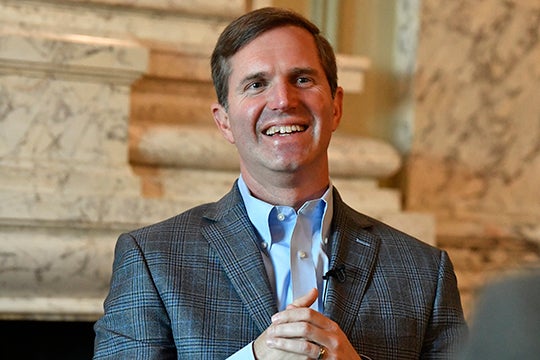Turnout, voting centers and early voting: How did the 2023 election go?
Published 11:15 am Tuesday, November 21, 2023

- How turnout changed between 2019 and 2023
The 2023 election season is over and the winners will soon be inaugurated. But in the meantime, let’s take one more look back at how things went, from the perspective of county clerks and Secretary of State Michael Adams.
Turnout
Thirty-eight percent of registered Kentucky voters showed up at the polls this election.
While that is lower than 2022’s midterm elections, which turned out 42%, and the 2019 gubernatorial election, which attracted an unusually high 44%, it was just a tick below average for a gubernatorial year, Adams said.
He said that he thinks that the primary driver of turnout is “people being upset.” That may have led to a record high national turnout in 2020 and a high 2019 turnout in Kentucky’s election, when Beshear faced an unpopular incumbent, former Gov. Matt Bevin.
“I think what that shows is that people didn’t hate Andy Beshear and they didn’t hate Daniel Cameron,” Adams said. “They’re both nice guys, both likable guys. And so people were against them, to be sure, but not with the kind of vitriol that you saw in 2019 or 2020.”
Crittenden County Clerk Daryl Tabor agreed.
While he expected a slightly higher turnout in his county, he said that it showed that people may have not felt compelled enough to make a change to show up to the polls.

How turnout changed between 2019 and 2023
Voting Centers
It may be premature to draw any conclusions about the effect of voting centers on turnout, said Dr. Stephen Voss, University of Kentucky associate political science professor and specialist in elections and voting behavior.
“Any change in voting laws usually comes with some friction, and at first, turnout tends to be lower,” Voss said. “So given that this was the first pass at vote centers (in a gubernatorial election), the full benefits of implementing them may not have kicked in yet.”
Tabor oversaw a mixed voting system this election, including one voting center and four precincts.
Marion, the county seat, is about a 20 to 30-minute drive from some remote corners of the county, so Tabor thought it was important to maintain precincts in the outlying areas for those who couldn’t or didn’t want to make the trip.
But the voting center was helpful for those who worked and shopped in Marion, he said. It also allowed Crittenden County to cut its voting machines by a third and require less poll workers, which have been difficult to find.
A lot of poll workers are older Kentuckians that the county lost in the switch to new voting machines with electronic pads to check in voters, Tabor said.
“After the 2020 election and the changes that brought about the voting centers, and just how contentious the presidential election was and how complicated elections have become, a lot of these veteran poll workers just decided they didn’t want to be part of it anymore,” he said.

Which counties used voting centers in 2023?
Carroll County exclusively used voting centers.
County Clerk Danielle Kinman said that after being required to use them during COVID, the community seemed to like them.
It also saved time, money and resources. Instead of 50 poll workers, they only need 32.
“We can kind of oversee it better with less places,” Kinman said. “We can be more present to help with issues more immediately than trying to be in 11 different places.”
Voss said that being able to concentrate a county’s best trained and most experienced poll workers in fewer places is one of the benefits of voting centers.
When problems arise with voters, it’s easier to get past the logjam, he said.
“So that’s not going to shape how many people in any given county are interested in voting,” Voss said. “What it is supposed to help is how many people who tried to vote succeeded.”
After becoming county clerk last year, Kinman added two voting centers to the original state park center to accommodate more people.
Not all Kentucky counties opted for voting centers. Bell County, for one, kept its 30 precincts instead.
County Clerk Debbie Gambrel said that they might change it one day, but they are satisfied with the current system for now.
“Everybody was accustomed to that procedure and where to go,” she said.
Adams said he wants to have serious, bipartisan conversations with the legislature on making sure there are enough voting locations to cover a comparably high turnout during the 2024 presidential election.
He thinks that having more locations on Election Day will be critical, since many Trump supporters prefer the traditional days to early voting.
“I am concerned that our current model is adequate for 38% turnout, but it’s not adequate for a 60% turnout,” Adams said.
Early Voting
Early voting is on a “use it or lose it” basis. Several county clerks said that while the no-excuse early voting was popular, the portion requiring an excuse was barely used at all.
Tabor said only 30 people took advantage of the six days of excused voting in Crittenden County, which was “kind of cumbersome.”
Perry County Clerk Wayne Napier said that he wishes the state would just go with no-excuse voting for a certain number of days.
“Let the excused go because it costs so much money to get the workers out to work the unexcused, and it’s just pretty much a waste of time in my opinion,” he said.
Adams said he would rather spend resources encouraging people to take advantage of current early voting days than to add more days.
“We saw an uptick in the proportion of voters that use early voting but we’re not at the level yet where I think that more days is going to make a huge difference,” Adams said. “Because you’re still talking about 19% of vote coming in over three days, and then like 80%-ish the last day.”
A Lesson for Republicans?
Adams still has a lot of analysis to do, but he already had some takeaways after the election.
First, he said that although Republicans have nearly 76,000 more registered voters than Democrats, about a two-point lead, that’s a red herring.
“That is a misleading indicator unless they can get those people to turn out and unless they can get their fair share of the Independents,” he said.
In 2019, Adams thought that the Kentucky Republican Party had the right message but the wrong messenger in Bevin.
He said that Cameron “proved him wrong” by getting an even lower vote share than Bevin despite being an “extremely likable, charismatic, articulate messenger.”
“What I think is our problem is, is our message,” Adams said. “And I think we better work on our brand and our style and our policies and our emphasis on real issues that actually affect people versus shiny objects and things to throw out to people to try to goose them to show up at the polls.”
The “Trumpy” voters didn’t show up to the polls en masse like they do during presidential years, Adams said, and a different population of voters requires a different campaign.
Democrats also have a geographical advantage, since they tend to live in more concentrated urban areas than sparsely populated rural areas, Adams added. That makes door to door canvassing to motivate the Republican base harder.
“So you’ve got to come up with a way to overperform with Independents and also get your own people out and it’s a difficult dance to perform,” he said. “Because the more you push to the right to get your base motivated, the more you lose the center and the more you court the center … it’s kind of a trap.”





